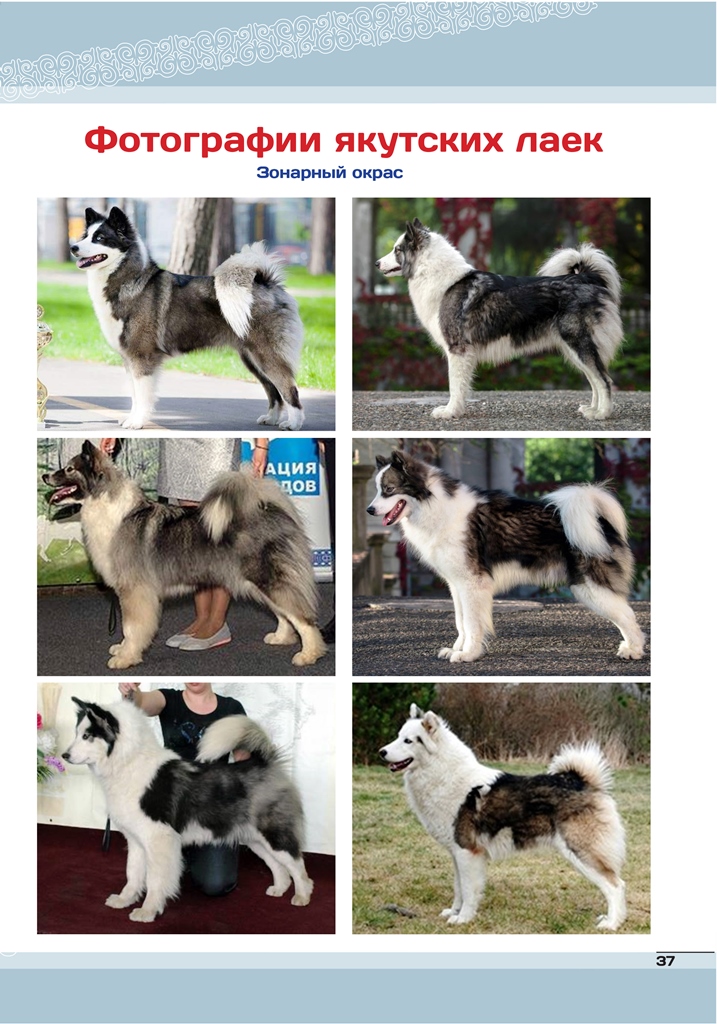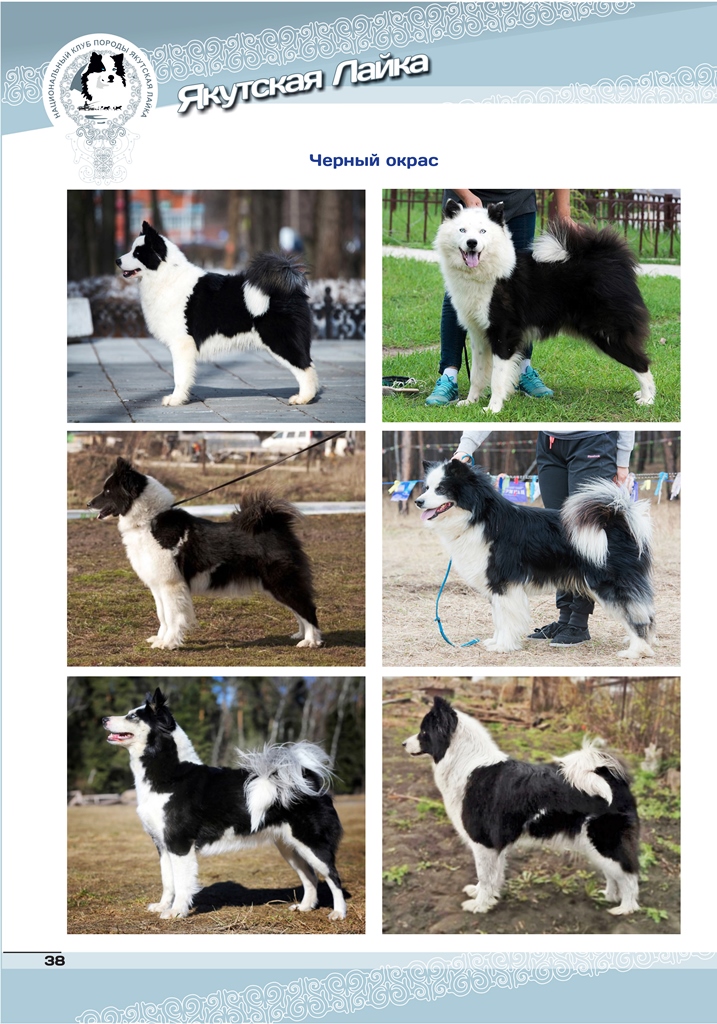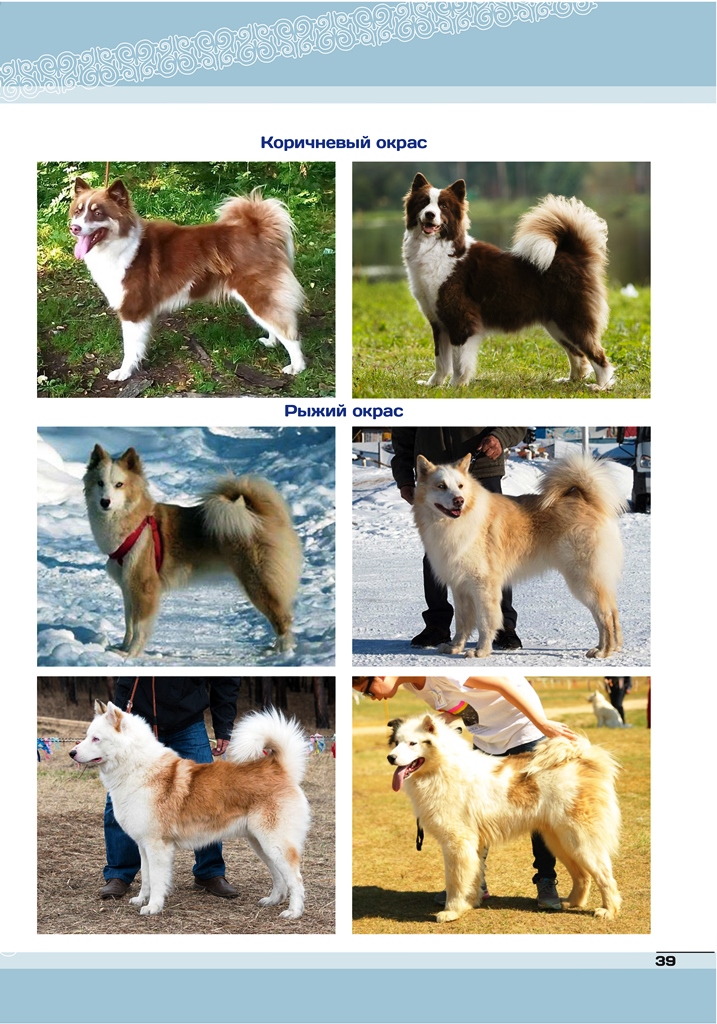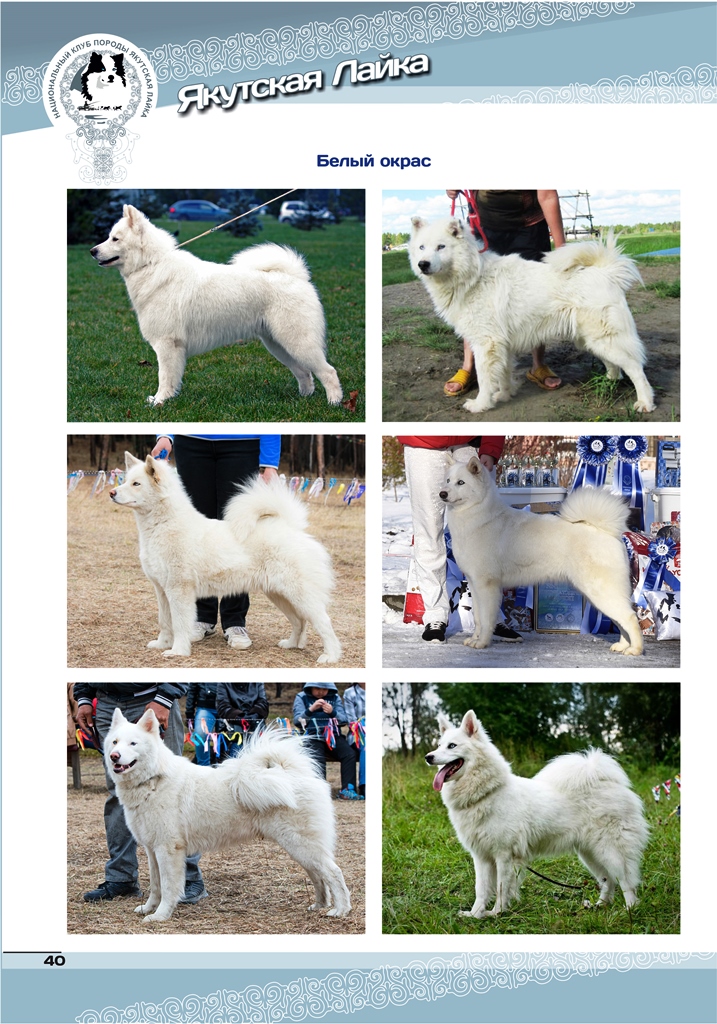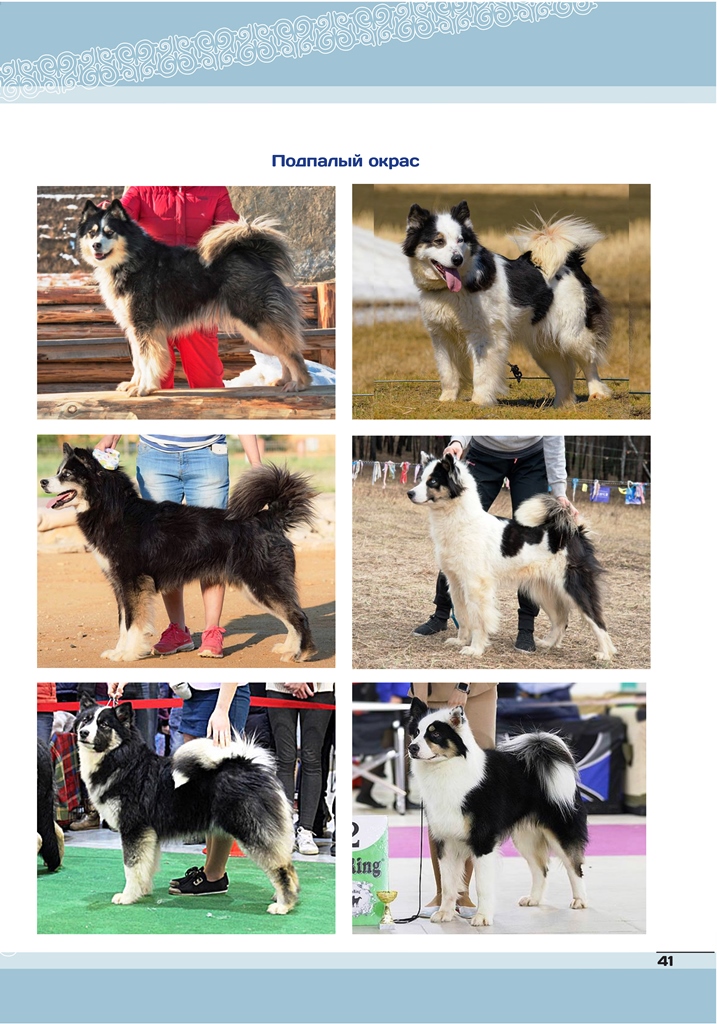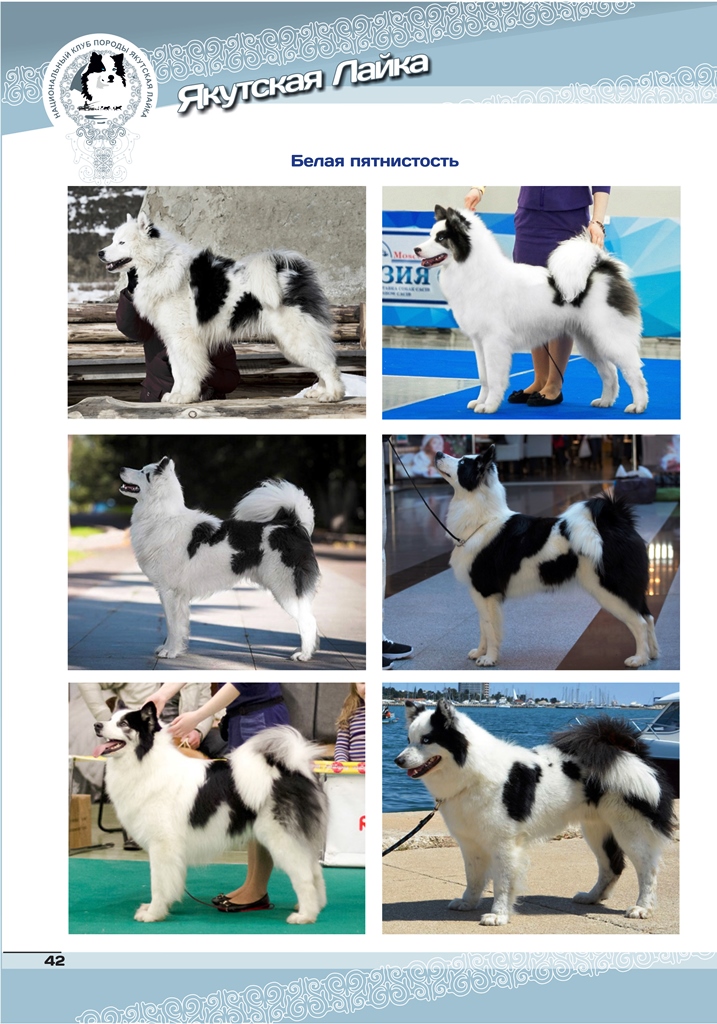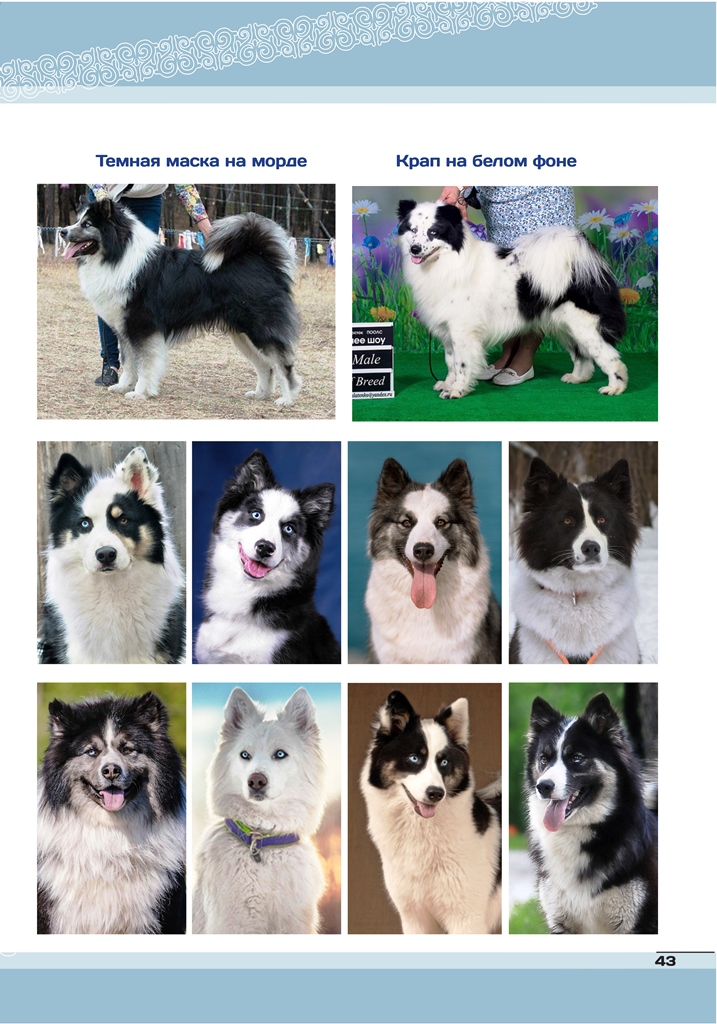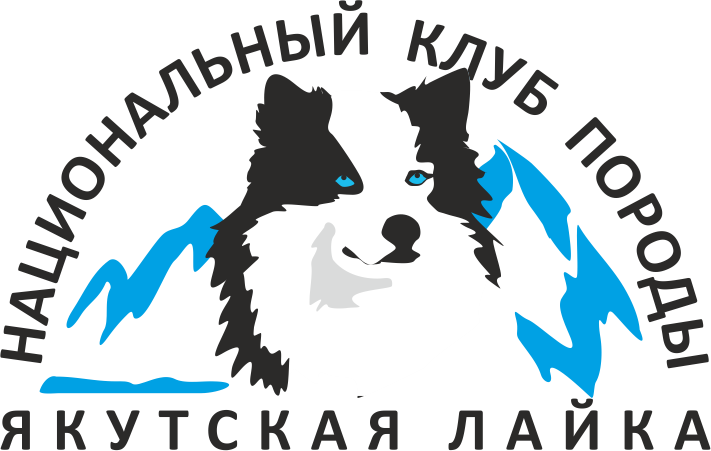Coat Colour Genetics in Yakutian Laika
Associate Professor of MGPPU, Candidate of Biological Sciences, teacher of zoopsychology.
Canine, owner of the kennel kennel White flock!
Author of several books about dogs, and the textbook "Zoopsychology and Comparative Psychology" for universities.
Coat colour according to the breed standard: White or particolour (bicolour or tricolour).
Yakutian laika coat colours: white, black, grey (agouti), tan point, brown, red.
All Yakutian laikas have a spotted coat. Spotting can be expressed to various degrees: from solid white to piebald with white spots occurring only in areas of primary depigmentation (on the chest, feet, muzzle, neck, tip of the tail). Spotting patterns can vary in symmetry.
Self-ticking is allowed. The white coat of the Yakutian laika is extreme spotting with small amounts of colour in one or several pigment centres (e.g. on the tips of ears, around eyes, on the neck).
Coat colour genetics
Main alleles for the coat colour of the Yakutian laika
aw– causes an agouti coat, a common allele for the Yakutian laika
ау– causes a sable coat; likely to occur in a small number of dogs
аt– causes a tan point coat
а – causes one of the eumelanin solid coat types; occurs in some black and brown (spotted) dogs
В – present in all non-brown dogs of the breed
в – causes a brown coat; occurs in brown, chocolate, and liver-coloured dogs
D – causes a colour of normal intensity; occurs in most dogs of the breed
d – causes dilution of pigment
Е – allows extension of eumelanin pigments over the whole body; present in dogs of most colours
Em– causes a dark mask, not common in the breed
е – restricts extension of eumelanins over the body; can cause a red or white coat
G – initiates progressive greying; not present in the breed
g –absence of progressive greying; present in all dogs of the breed
I – responsible for normal phaeomelanin synthesis
i – inhibits phaeomelanin synthesis
KВ – causes a solid black or brown coat
ky – causes agouti, sable, and tan point coats; occurs in most dogs of the breed
S – responsible for a solid colour without white areas; not typical for the breed
s – causes white spotting; present in all dogs of the breed
sw – causes extreme spotting; occurs in white dogs
T – responsible for self-ticking on white areas; not desirable in the breed. Can occur in spotted dogs.
t – absence of ticking on white areas
Agouti
The group of Northern spitz-type dogs demonstrates extraordinary variety of agouti phenotypes. The agouti coat colour depends on the length, thickness, and location of hairs on the body. As a rule, short fur on the legs and muzzle is lighter as well as fur on the chest, culottes, etc. These markings form a specific pattern which slightly resembles a tan point or saddle pattern but is never as distinctively shaped. The head also has various markings that range from light tan shading on the cheeks, lips, and pips above the eyes to a distinct reverse mask.
Reverse mask
A reverse mask, common in the Siberian husky and the malamute, can sometimes occur. Modern molecular genetic methods have not yet identified this allele (or alleles), but it is obviously present in a number of breeds. Some researchers call this factor “Husky Pattern Domino” http://nicholescritters.homestead.com/malcolorgenetics.html The urajiro pattern typical of Japanese breeds is likely to be determined by a similar factor.
The shades of the agouti coat vary considerably. The hairs can be brownish with well-defined yellow, orange or red bands and correspondingly coloured markings with shorter or lighter fur. This wild type of coat is common for many Northern spitz-type dogs. The intensity of the grey agouti colour is determined by numerous modifier genes that cause variations in the width ratio of hair bands. Wider yellow bands result in a grey-red agouti, wider colourless bands result in an overall lighter coat, and considerably narrower yellow and colourless bands result in almost completely black fur.
Shading polygenes also contribute significantly to this type of coat. They promote widening of eumelanin bands at the tips of hairs. The grey agouti coat with long dark-tipped hairs is sometimes referred to as wolf sable. The main alleles responsible for this coat colour are аwаw В-kyky.
In some cases the tipped agouti coat colour can be determined by heterozygotes awat due to incomplete dominance between the alleles. There are some alleles widely present in the breed that have not yet been identified conclusively by modern molecular genetic methods and that inhibit phaeomelanin synthesis in banded hairs resulting in a silver shade of agouti (similar to the salt-and-pepper coat of schnauzers). In this case light markings become white or light grey more or less contrasting with the main colour of the coat.
When yellow and colourless hair bands are wider than black ones, the result is an overall lighter coat colour. Extreme lightening of phaeomelanin areas causes such dogs to look almost completely white.
When black eumelanin is replaced by brown, the result is a brown agouti.
Possible genetic formulae for the agouti coat colour:
awaw В-С-D-Е-kykyss – grey agouti
awaw bbС-D-Е-kykyss – brown agouti
Black
The Yakutian laika has two types of black coat colour:
- Dominant, where the main genes responsible for colour are В-D-E-KВ.
- Recessive, where the main genes responsible for colour are aaB-E- .
Yakutian laikas that are solid black or black with minor white markings are extremely rare, but black with white spotting is one of the most common coat colours.
A heavily tipped agouti coat can look almost black.
Black-and-tan dogs can look black-and-white as tan points can be almost completely reduced by white spotting.
Possible genetic formulae for the black coat colour:
1. a?a? B-C-D-E-KВ-ss – dominant black
2. aa B-C-D-E-KВ-(kyky)ss – recessive black
3. awaw B- C-E-kykyss – tipped agouti
4. atat B- С-E- kyky ss – tan point
Brown
The Yakutian laika can have two types of brown coat colour: caused by bb -D-E-K genes and by aabbE- genes. Brown agoutis, sables with long brown hair tips, and brown tan points with points reduced by white spotting can appear brown. In this case the nose leather, eye rims, and nails are also brown.
Possible genetic formulae for the brown coat colour:
1. a?a? bbC-D-E-KВ-ss
2. aa bbC-D-E-KВ-(kyky)ss
3. awaw bb C-E-kykyss -
4. ayay bbС-E- kyky ss
5. atat bb С-E-kyky ss
Unfortunately, these formulae do not include such important factors as the alleles that cause wider brown hair bands and determine the degree and distribution of white spotting.
Red
Red coat colour in Yakutian laikas is less common than black but can occur. There are various types of red coats.
The basic red coat colour is sable of the ayaykyky genotype with a distinctive light “wild” pattern on the body. The pattern is similar to that of grey agouti dogs.
This type of coat is red with dark tipped hairs. The relative length of dark tips can vary significantly, which results in a lighter or darker coat colour. The variability of this character is determined by a system of modifier genes – shading polygenes.
The sable coat colour is highly age-variable. Puppies that still have soft, fine fur are grey and resemble agouti puppies. They acquire the distinctive colour together with the adult coat.
When the black pigment is replaced by brown, a sable dog’s hair tips become brown; if the hair tips are short, dogs phenotypically look pure red. Brown nose leather and pink lips indicate that a dog has brown pigment.
The second type of red coat is caused by the ее alleles restricting extension of eumelanin that has an epistatic effect on the other coat colour genes. Such dogs can carry any genes.
Possible genetic formulae for the red coat colour:
ayay в-С-D-Е- kykyss – red with black nose
ayay bbС-D- E-kyky ss – red with brown nose
a?a?В-С-D-ee KВ-(kyky) ss – red
White
A genetically white coat colour can be determined by various loci. In most cases it is initiated by the ee alleles in combination with the ii alleles that inhibit phaeomelanin synthesis in hairs. In fact, it is a diluted red. As experience shows, the ii alleles do not always completely remove phaeomelanin from the coat, so white dogs often appear to have a cream coat. White dogs with black nose leather, lips, and eye rims and dark-coloured eyes carry the B- allele. Homozygous white dogs carrying the bb alleles are born with brown nose leather and pink skin.
Many white dogs have the extreme spotting pattern, i.e. they are homozygous carriers of the swsw alleles. This is true for most dogs with spotted coats. Such dogs have minor dark spotting in areas of remaining pigmentation, e.g. tips of ears, neck, set of tail. The spotting can be expressed as single dark hairs, which is practically unnoticeable.
In some cases extremely light agoutis or sables can be almost completely white. Such dogs can have some minor shading on the back.
Besides the alleles mentioned above, other factors that do not have any direct effect on the coat colour can cause a white coat. Among such factors are the depth of pigment in hairs, the thickness and transparency of the hair cortex, the texture of hairs, etc.
Possible genetic formulae for the white coat colour caused by combinations of the ее and ii alleles:
With black nose leather
awaw В- D-ееii (KВ-)kyky ss
ayayв- D-ееii(KВ-)kyky ss
atat B- D-ееii(KВ-)kyky ss
With brown nose leather
awaw bbD-ееii (KB-)kyky ss
ayay bbD-ееii(KB-)kyky ss
atatbbD-ееii(KB-)kyky ss
Tan point
The tan point coat colour is caused by the combination of the alleles аtаtB-kyky. The allele combination аtаtbbkyky causes a brown tan point coat that is often considered brown, and its light variants are considered red. The presence of the ii alleles can turn tan points into almost white. This type of coat colour is usually combined with white spotting.
Genetic formulae for the tan point coat colour:
аtаt B-С-D-E- kyky ss – black tan point
аtаtbbС-D-E- kyky ss – brown tan point
White spotting
The Yakutian laika exhibits a wide variety of white spotting, from almost solid dark coats to almost completely white, with an array of intermediate piebald and spotted types. Virtually all dogs of the breed carry the homozygous pair ss.
Piebald and spotted dogs can develop ticking on white areas caused by the dominant T allele.
|
Pattern |
Bicolour |
Tricolour |
|
Spotted – white with pigmented patches. |
White and black, white and grey, white and red, white and brown, white and black with ticking. |
White, black, and red; white and black with tan points; white, black, and red with ticking. |
|
Piebald – pigmented coat with white patches. |
Black piebald, grey piebald, red piebald. |
Black, white, and red; black and white with tan points; black, white, and red with ticking. |
|
Extreme spotting, almost completely white. Dark spots in pigment centres only. |
Dark mask on the muzzle
Agouti and sable coats can be accompanied by a dark mask caused by the Em allele, but it is often covered up by white spotting.
Translated by Marina Petrova
